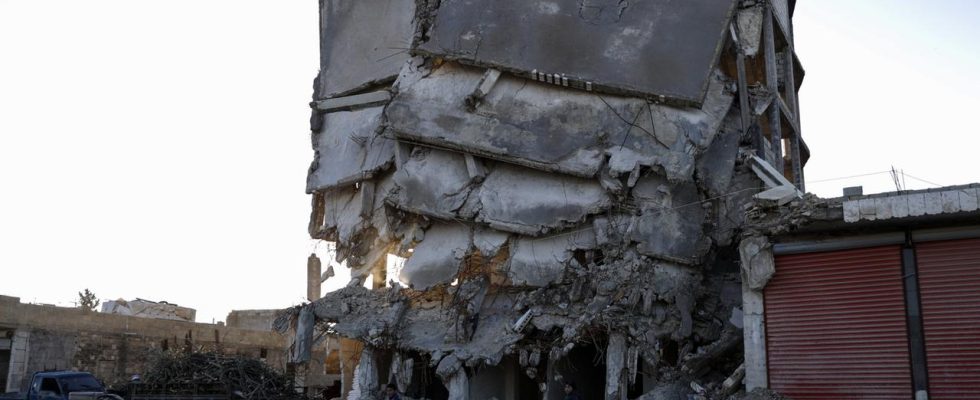report
A year ago, northwestern Syria was hit by a severe earthquake. Help arrived slowly through a single border crossing – too late for many. Hundreds of thousands of people still live in tents.
Hamza el Ahmed learns to walk. The lanky 15-year-old struggles along a railing. It’s been exactly a year since everything changed for the boy from Jindires in northwest Syria.
“It was four in the morning, I was sleeping. Then the earth shook, the house shook, we all gathered in a room. My big sister picked up my little sister and ran out, I followed.” When he was at the door, the power suddenly went out and then the house collapsed, he says. He was buried under the rubble. “I called out to my father under the rubble to get me out of here, but he replied: ‘I can’t.’ Then I fainted.”
Buried under rubble for 35 hours
The teenager lay buried in the ruins of his parents’ home for 35 hours. What Hamza didn’t know at the time: his parents and several siblings didn’t make it and died under the rubble.
“When I regained consciousness, I wanted to move, but I couldn’t, I was totally under the rubble. I screamed and then the civil defense came to free me. My leg and my hand were under the rubble stuck, so they dug for a long time to get me out,” says Hamza.
Hamza’s right leg cannot be saved and has to be amputated in the hospital. His arm is also seriously injured – only now, after a year, can he slowly move his fingers again. The orphan carefully finds his way back to life: he receives therapy and a prosthetic leg and practices running. His older brother survived – he can live with him.
And Hamza is still lucky: a year after the earthquake, hundreds of thousands of people in northwestern Syria are still homeless and living in tents. There are also millions of people who have been living in refugee camps here for years due to the Syrian civil war.
UN coordinator David Cardin says: “The situation in northwest Syria remains terrible even a year after the earthquake. More than 3.4 million people are internally displaced – around half a million more than before the earthquake. Four million people need medical care. “
“We call the tent cities mud camps”
“We refer to the tent cities in which people live as mud camps,” reports Ismail Abdallah from the civil protection organization White Helmets. “Because the rain turns the camps into swamps.” The winter here in northwestern Syria is a catastrophe for these people – diseases are spreading, Abdallah continued. “But the number of hospitals is not enough to care for everyone. There have been cases of cholera, and now in the winter there are respiratory diseases because there is no heating. People throw everything flammable into the fire to warm themselves and their children . They burn garbage or old shoes. Many people have bronchitis.”
The earthquake in Syria primarily hit a region that has been marked by hardship and violence for years: the Idlib province in northwestern Syria is controlled by partly extremist insurgents and armed militias and is cordoned off. The only access for aid deliveries is a monitored border crossing from Turkey. But after the devastating earthquake, it took days for aid to get underway in northwestern Syria, and two more border crossings were later opened. Valuable time passed in which the people in the region were left to their own devices, digging for the missing people with their bare hands.
“We lacked the equipment”
Abdallah from the White Helmets continues: “We lacked equipment to locate and rescue those buried. We would have needed heat sensors and heavy equipment to clear the rubble, such as bulldozers or dump trucks. We didn’t even have diesel. We had to rely on ours “We were left with primitive hand tools and couldn’t reach everyone, so a lot of people died. If we had the equipment, we could have saved the people.”
It also took a long time for the first aid planes to land in the areas controlled by Syria’s dictator Bashar al-Assad. In the northwest the situation was even worse. When the first trucks finally rolled across the Turkish border into northwest Syria after a few days, help came too late for many. Observers reported in disbelief that the first aid transports contained standard relief supplies such as detergent – instead of the urgently needed rescue supplies. UN emergency relief coordinator Martin Griffiths later publicly apologized for his organization’s delayed response.
To this day, Abdallah cannot understand this: “Even now, even after a year, we are still asking ourselves a question to which we cannot find an answer: Why were we ignored? Why did the international community ignore us in the golden 72 hours, in which we could have saved people? It would have been possible to save people’s lives. Why was help delayed?”
The trauma of the night of the earthquake remains
The people in northern Syria will probably never get an answer to these questions. For 15-year-old Hamza, who lost his leg and his parents in the earthquake, the memory remains, the trauma of the night of the earthquake: “I still hear the screams, to this day. The screams from our house and from the neighbors. Man told me that my mother also screamed for a long time before she died. To this day I can no longer hear loud words.” And later he says: “Many people here will never forget this earthquake.”
Anna Osius, ARD Cairo, tagesschau, February 6, 2024 7:47 a.m

